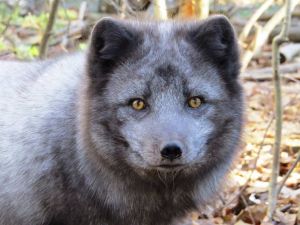
An Arctic canid
The arctic fox has some pretty impressive adaptations to its life in the tundra. As its name suggests, it lives in the arctic regions of North America and Eurasia. During the summer, its fur is dark brown or yellowish. In the winter, its fur turns white or blue, from blue-black to pearl grey. This change in color enables it to hide in its environment.
The hairs of its fur are long and fluffy, making it the most insulating fur of all mammals. It is so warm the fox can withstand temperatures as cold as -70°C before shivering. Its nose, ears and legs are short to limit heat loss. The pads on its paws are very vascularized and covered with fur, protecting the paws from frost. During intense cold or storms, the fox curls itself up in a ball, covering its nose and paws with its bushy tail.
Its diet is also an adaptation to its life in the tundra. It mainly eats lemmings and voles. Besides, the arctic fox populations fluctuate in a three to four years cycle, in relation to the lemming populations. Sedentary during the upbringing of the pups, it becomes nomad in the winter, especially when the food is scarce. It can travel hundreds of kilometers, sometimes following polar bears in order to eat the remaining of the kills.
All its adaptations, physical and behavioral, allow the arctic fox to survive in an environment where few animals are able to do it.
Author: Stéphanie Bentz, biologiste responsable de l’éducation
Source: Prescott, Jacques et Pierre Richard. Mammifères du Québec et de l’Est du Canada. Waterloo : Éditions Michel Quintin, 2004. Imprimé.
Photo: Stéphanie Bentz
